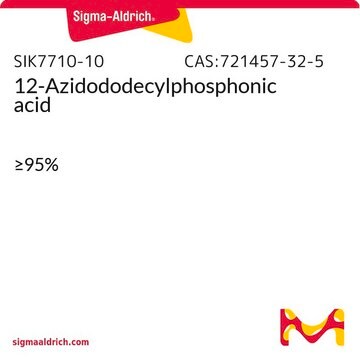All Photos(3)
About This Item
Empirical Formula (Hill Notation):
C12H27O3P
CAS Number:
Molecular Weight:
250.31
MDL number:
UNSPSC Code:
12352103
PubChem Substance ID:
NACRES:
NA.23
Recommended Products
form
solid
Quality Level
mp
68-73 °C
SMILES string
CCCCCCCCCCCCP(O)(O)=O
InChI
1S/C12H27O3P/c1-2-3-4-5-6-7-8-9-10-11-12-16(13,14)15/h2-12H2,1H3,(H2,13,14,15)
InChI key
SVMUEEINWGBIPD-UHFFFAOYSA-N
General description
Styryl 9M is an organic laser dye that is used as a non-linear optical(NLO) component. It is biocompatible in nature and can be used as a chromophore for photon absorption based microscopy.
Application
Styryl 9M may be used as a near-infrared based dyes that can be incorporated with amino functionalized polystyrene nanoparticles for the tracing and tracking of tumor cells. It exhibits non-linear optical properties which may be used in the fabrication of photonic crystal for application as ultrafast optical switches.
Tuning of surface energy, wetting, and work function of metal oxides
Storage Class Code
11 - Combustible Solids
WGK
WGK 3
Flash Point(F)
Not applicable
Flash Point(C)
Not applicable
Certificates of Analysis (COA)
Search for Certificates of Analysis (COA) by entering the products Lot/Batch Number. Lot and Batch Numbers can be found on a product’s label following the words ‘Lot’ or ‘Batch’.
Already Own This Product?
Find documentation for the products that you have recently purchased in the Document Library.
Customers Also Viewed
Long-chain functional bisphosphonates: synthesis, anticalcification, and antiresorption activity
Meziane, D.;
Heteroatom Chem., 20, 369-377 (2009)
Ultra-fast optical switches using 1D polymeric photonic crystals.
Katouf R, et al.
Ultra-fast optical switches using 1D polymeric photonic crystals, 3(2-3), 116-119 (2005)
Environment-sensitive two-photon dye
Linear and Nonlinear Optics of Organic Materials VIII, 7049, 70490Y-70490Y (2008)
Target-specific nanoparticles containing a broad band emissive NIR dye for the sensitive detection and characterization of tumor development.
Behnke T, et al.
Biomaterials, 34(1), 160-170 (2013)
Sandra L Pittelli et al.
ACS applied materials & interfaces, 10(1), 970-978 (2017-12-22)
To achieve optimal performance in a conjugated polymer-based electrochemical device, i.e. for a supercapacitor to reach full depth of discharge or for an electrochromic device (ECD) to achieve maximum contrast, the two electrodes must be in different oxidation states when
Our team of scientists has experience in all areas of research including Life Science, Material Science, Chemical Synthesis, Chromatography, Analytical and many others.
Contact Technical Service














